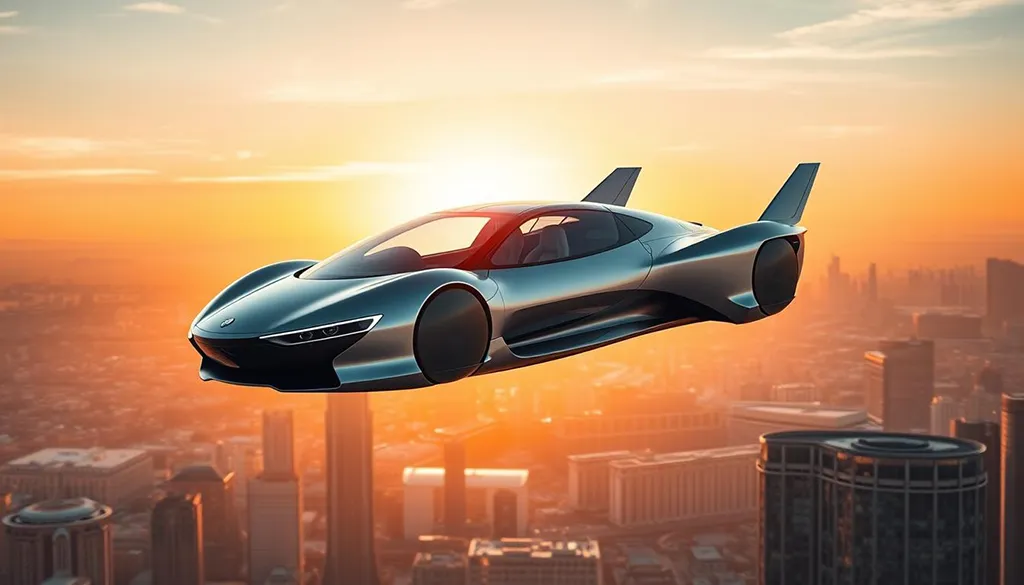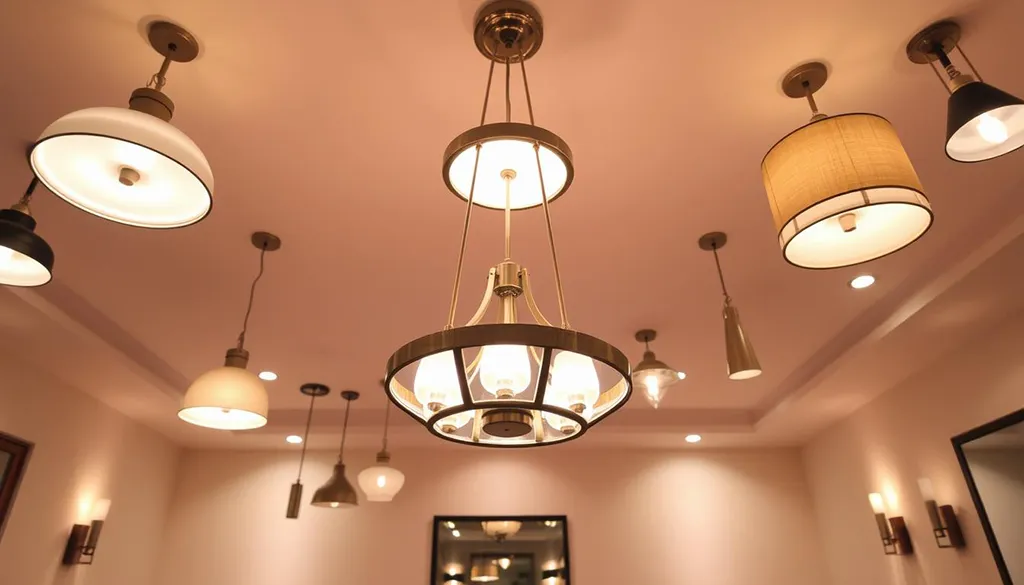The idea of flying cars is exciting and has caught the attention of people everywhere. Today, I’m sharing 15 new flying car design that could change how we move around cities. These designs aim to solve traffic problems and bring together the latest tech and creativity.
By looking at these ideas, I hope to show you how our future transportation might look. It could be a big change, moving from roads to skies.
Key Takeaways
- The flying car design concept aims to revolutionize urban transport.
- Innovative transport technology can significantly alleviate traffic congestion.
- Advancements in design and functionality are key for future flying cars.
- Flying cars promise to fit well into city life.
- Exploring these designs could lead to safer, more efficient travel.
The Evolution of Flying Car Design
The journey of flying car design has been amazing. It’s filled with bold visions and big tech leaps. From simple ideas to complex prototypes, it’s grown a lot. Designs have mixed dreams with real engineering, leading to new vehicle ideas.

The Evolution of Flying Car Design
Today, flying car design is all about new tech. It’s turning dreams into real things we can use.
Early Concepts and Inspirations
Flying cars have excited people for over a century. Pioneers like Glenn Curtiss showed off the Autoplane in 1917. It had a huge wingspan of 40 feet.
In 1946, the Airphibian flew at 120 miles per hour and drove at 50 miles per hour. But, the Taylor Aerocar only made six in 1949. This shows the big hurdles in making flying cars for everyone.
The Role of Technology in Advancements
New tech has really helped flying car design. Over 400 startups are now working on flying cars. This shows a big growth in the field.
The FAA has approved flying cars from Alef and Doroni Aerospace. This makes flying cars seem more real. Cars like ASKA’s A5 can go 150 miles per hour. This shows how far we’ve come.
Now, we’re seeing electric cars and AI helping with air traffic. This is making flying cars safer and more efficient. It’s a new era in flying car design.
Top 15 Futuristic Flying Car Design Ideas
The world of urban transport is changing fast, thanks to new flying car designs. These designs mix creativity with technology, leading to better ways to move around cities. Famous designers and groups are exploring new ideas, making our daily trips to work or school exciting.
Innovative Concepts from Leading Designers
The AeroMobil 4.0 stands out for its advanced engineering. It makes flying smooth and stable. The PAL-V Liberty is special because it’s both a car and a gyroplane, with a rotor and propeller that fold away.
- Terrafugia Transition: A foldable-wing design enabling seamless transitions between road and air travel.
- Kitty Hawk Flyer: An electric-powered aircraft aimed at reducing environmental impact.
- Volocopter: Designed for short flights, it’s eco-friendly and perfect for cities.
- EHang 216: An autonomous eVTOL for passengers, tackling regulatory hurdles.
- Lilium Jet: A five-seater electric aircraft for busy cities, with vertical takeoff and landing.
Impact on Urban Mobility
Flying cars could change how we move around cities a lot. They could make traffic better and save time. For example, the CityHawk focuses on safety in cities, while Vahana, backed by Airbus, aims to change city planning with short-distance flights.

Top 15 Futuristic Flying Car Design Ideas
| Flying Car Model | Key Features | Potential Urban Mobility Impact |
| AeroMobil 4.0 | Smooth flight, land/air versatility | Improves access and reduces congestion |
| PAL-V Liberty | Gyroplane agility with road capabilities | Flexible use across terrains |
| Lilium Jet | Vertical takeoff and landing | Enhances short-distance travel options |
| Joby Aviation | Electric air taxi, ride-sharing integration | Transforms urban transport landscape |
| Samson Sky Switchblade | Folding wings for practical use | Optimizes space and location accessibility |
Aerodynamic Features in Flying Cars
Aerodynamics is key in flying car design. It helps them lift and stay stable in the air. By using aerodynamic designs, flying cars can move more efficiently, saving fuel and improving performance.
Importance of Aerodynamics
Good aerodynamics lets flying cars move smoothly in the city skies. They need streamlined shapes and wing designs to cut down on drag. This isn’t just for looks; it’s critical for flying in tight spaces and busy air.
Design Examples Emphasizing Aerodynamics
Take the PAL-V Liberty, for example. It’s a car and a plane all in one, thanks to its smart design. The Switchblade is another standout, with a big wing for better lift. It’s designed to fly fast and cut down on drag.

Aerodynamic Features in Flying Cars
Designs are getting better, thanks to advanced aerospace techniques. As more companies work on flying cars, we’ll see even more exciting designs. This will lead to a new way of moving around cities.
Next-generation Urban Mobility
The future of city travel is changing with flying cars. They aim to solve the problem of traffic jams in growing cities. Flying cars use the air above roads, making travel faster and more efficient.
Addressing Traffic Congestion with Flying Cars
As cities get more crowded, old ways of getting around won’t work. Flying cars could change how we travel in cities. They can carry many people and take off from busy streets.
Many companies are working on flying cars. They think this market will grow a lot. Most city people are excited about flying cars as a solution to traffic.
Here are some cool flying car designs:
| Flying Car Model | Passenger Capacity | Maximum Speed | Range |
| CityAirbus NextGen | Up to 4 | 120 km/h | 80 km |
| Lilium Jet | 5 | 300 km/h | Not specified |
| PAL-V | 2 | 160 km/h | 1,315 km |
| Joby Aviation’s S2 | 4 | 320 km/h | 150 miles |
| Jetson ONE | 1 | 102 km/h | 20 minutes flight time |
Flying cars are getting better and could make cities cleaner and more efficient. They might cut down traffic jams by 40% and travel times by 60%. But, we need to solve problems like noise and safety to make them work.
Flying Car Design Innovations to Watch
Flying car designs are getting better, and they’re becoming part of smart city plans. Cities are getting smarter, using data to manage traffic and keep everyone safe. This helps flying cars work better, making our future travel smoother.
Integration with Smart City Infrastructure
Flying cars need to work well with city systems. Here’s what’s important:
- Traffic Management: Systems can watch the skies, making traffic flow better.
- Data Sharing: Cars and cities talk to each other, making travel safer and faster.
- Charging Stations: Easy-to-find charging spots make flying cars more convenient.
Advanced Aerospace Design Techniques
Safe and efficient flying cars need advanced design. Alef Aeronautics is at the forefront, testing and improving their designs. The Model A has:
- Triple to octuple redundancy for key parts.
- A ballistic parachute for emergencies.
- Systems to avoid obstacles and keep flights safe.
AeroMobil also shows off advanced design. It’s been tested for over 350,000 hours. It can switch from car to plane in under three minutes. Its hybrid engine offers great power and range, meeting city needs.

Flying Car Design Innovations to Watch
People are really interested in flying cars, with over 3,330 pre-orders for the Model A. The market is expected to hit $70 billion soon. This means flying cars could change how we move around cities.
The Role of Hybrid Car-Aircraft Design
Hybrid car-aircraft designs merge car and plane tech, aiming to change how we travel. They could make vehicles that move on roads and fly, changing city travel. This could make moving around cities much easier.
Benefits of Hybrid Designs
Hybrid designs offer big benefits, like cutting travel times in cities. They help avoid traffic jams. They also cut down on pollution, making travel greener.
These vehicles can take off and land in small spots. This makes them perfect for city living, where space is limited.
Examples from Current Innovations
Companies like Klein Vision and Bellwether are leading in hybrid car-aircraft tech. Klein Vision’s AirCar has flown over 70 hours, reaching speeds of 300 km/h. It can travel up to 1,000 kilometers.

The Role of Hybrid Car-Aircraft Design
Bellwether’s Volar eVTOL has flown to 4 meters high at 40 km/h. Its full-size model is coming in 2023. Alauda Group’s Airspeeder Mk3 can lift heavy loads and hit 100 km/h.
New Future Transportation’s Aska uses electric charging spots and fits in parking spaces. The Heart ES-30 can carry 30 people and runs on green fuel. These examples show how hybrid designs are improving travel and the environment.
Visionary Transportation Concepts
Flying cars are a big step towards the future of getting around. They are changing how we think about traveling and city planning. With over 200 companies working on flying cars, big names like Boeing, Airbus, and Toyota are putting a lot of money into this new idea.

Visionary Transportation Concepts
These companies are working together to make flying cars a part of our daily lives. They want to make it easy to get around cities and connect them to airports. This could make traveling faster and easier, helping to reduce traffic jams.
How Flying Cars Transform Transportation
Flying cars could do more than just make travel easier. They are also changing how we think about getting from one place to another. Companies like Lyft are teaming up with flying car makers to create new taxi services.
These services could help people get to airports without dealing with traffic. Larry Page, the co-founder of Google, is also investing in flying car technology. His support is helping to move the industry forward.
Potential Challenges Ahead
Even though flying cars are exciting, there are big challenges to overcome. Making them stable and efficient is a major task. Also, we need new rules to make sure flying cars are safe.
Getting people to trust flying cars will be key. We need to address concerns about safety, cost, and how practical they are. If we can solve these problems, flying cars could change the way we travel forever.
Real-World Applications of Flying Car Designs
Flying cars are moving from science fiction to our daily lives. The FAA’s approval of the Alef Model A for test flights is a big step. It shows how electric flying cars are becoming a reality. The Aska A5, which can travel up to 250 miles, shows how prototypes are getting closer to being ready for the market.

Real-World Applications of Flying Car Designs
The idea of flying cars has been around for over a century. The first attempts were in 1917. Now, we have models like the Pal-V that can be ready to fly in just 10 minutes. These advancements highlight the practicality of flying cars and the rules being made for them.
The future of flying cars looks bright. Analysts think the autonomous urban aircraft market could hit $1.5 trillion by 2040. Flying cars could change how we move in cities, making it easier to get around. By 2030, getting an air taxi might be as simple as ordering food.
FAQ
What are flying cars?
Flying cars are vehicles that can drive like cars and fly like planes. They aim to solve city traffic problems by giving people new ways to travel.
How do flying cars enhance urban mobility?
Flying cars use the sky to cut down on traffic jams. They can take off and land anywhere, making city travel easier.
What are some notable flying car design concepts currently in development?
Designs like AeroMobil 4.0 and Terrafugia are making waves. They offer features for city commuters and blend car and plane tech.







